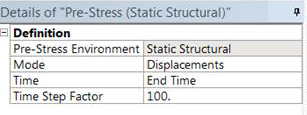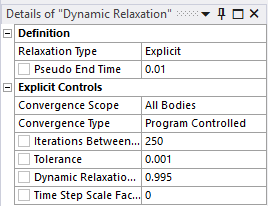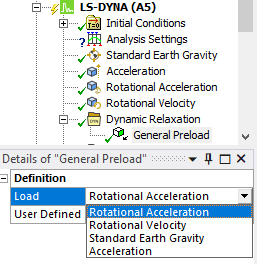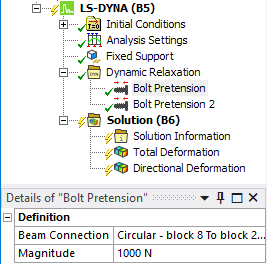Sometimes a preload must be applied prior to an explicit dynamic analysis, especially for engineering problems where a structure's initial stress state affects its dynamic response. Dynamic relaxation serves that purpose. It can be achieved by using an implicit solver or the explicit solver itself.

*CONTROL_DYNAMIC_RELAXATION
In LS-DYNA, three types of dynamic relaxation are available.
The first type of dynamic relaxation is "Explicit after Ansys Solution", which involves performing an Ansys implicit structural analysis followed by a LS-DYNA explicit dynamic analysis.

In this implicit-to-explicit sequential solution, you must first run an Ansys implicit structural analysis to apply a preload to the structure being analyzed. In this implicit analysis, completely constrain all of the nodes of any elements that will only be used in the explicit analysis (for example, the bird in a bird-strike problem). The nodal displacements and rotations at the time specified in the pre-stress environment from the Ansys implicit solution are written to the LS-DYNA dynamic relaxation file input.sif .

Card
TSSFDR is the time scale factor for computed time steps during dynamic relaxation, read from the Time Step Scale Factor under the Explicit Controls section. If zero, the value is set to TSSFAC (defined through the Time Step Safety Factor under Analysis Settings ). After converging, the scale factor is reset to TSSFAC.

NRCYCK is the number of iterations between convergence checks for dynamic relaxation option, read from Iterations Between Convergence Check under the Explicit Controls section. Default = 250.
DRTOL is the convergence tolerance for the dynamic relaxation option, read from Tolerance under the Explicit Controls section. Default = 0.001.
DFFCTR is the dynamic relaxation factor read from Dynamic Relaxation Factor under the Explicit Controls section. Default = 0.995.
IDRFLG is the dynamic relaxation flag for stress initialization and is set to 2 (initialization to a prescribed geometry).
The second type of dynamic relaxation, Explicit, allows the explicit solver to conduct a quasi-static analysis by increasing the damping until the kinetic energy drops to zero.
In that case, the solver will check the kinetic energy every 250 cycles (by default) until the kinetic energy from the applied preload is dissipated.
Five preloads are supported: Gravity, Acceleration, Rotational Acceleration, Rotational Velocity, and Bolt Pretension.

The dynamic relaxation parameters are identical to the dynamic relaxation of type Explicit after Ansys Solution, except for the parameter IDRFLG (dynamic relaxation flag for stress initialization):
IDRFLG = 1 (dynamic relaxation is activated) if the Convergence Scope is set to All Bodies
IDRFLG = 3 (dynamic relaxation is activated), if the Convergence Scope is set to Geometry Selection.
The third type of dynamic relaxation allows LS-DYNA to initialize Implicitly instead of Explicitly.

The dynamic relaxation parameters are identical to the dynamic relaxation of type Explicit after Ansys Solution, except for the parameter IDRFLG (dynamic relaxation flag for stress initialization):
IDRFLG = 5 (initialize implicitly).
The following 4 keywords setting up the implicit initialization are then written:
*CONTROL_IMPLICIT_GENERAL_DYN
DT0 is read from Initial Time Step under the Implicit Controls section
*CONTROL_IMPLICIT_SOLUTION_DYN
DCTOL is read from Displacement Convergence under the Implicit Controls section
LSTOL is read from Line Search under the Implicit Controls section
*CONTROL_IMPLICIT_SOLVER_DYN
LPRINT = 1 (Linear solver print flag, controls screen and message file output)
*CONTROL_IMPLICIT_AUTO_DYN
IAUTO = 1 (Automatic time step control flag)
Preloading can be done with a General Preload or Bolt Pretension object. Four loads are available for General Preload: Standard Earth Gravity, Acceleration, Rotational Acceleration, and Rotational Velocity. The Load field must be assigned accordingly.


*INITIAL_AXIAL_FORCE_BEAM
This keyword is used when a given beam connection has a Bolt Pretension load applied in the dynamic relaxation.


